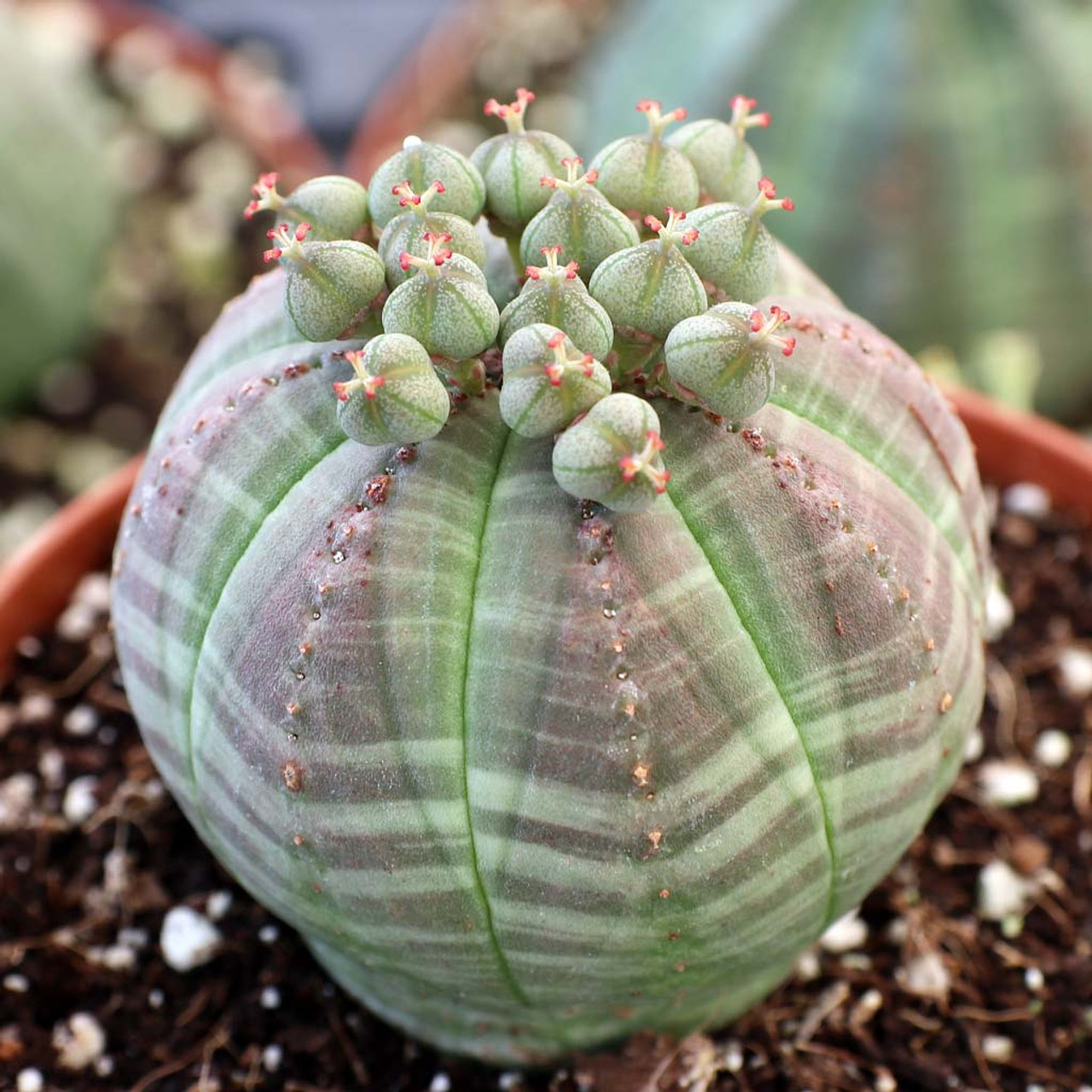The Enigmatic Euphorbia Obesa: A Botanical Marvel
Euphorbia obesa, often referred to as the “baseball plant” or “living baseball,” is a captivating succulent that has garnered significant attention from plant enthusiasts and collectors worldwide. Its unique spherical shape, intriguing patterns, and resilience in arid environments make it a true botanical marvel. This comprehensive article delves into the various aspects of Euphorbia obesa, exploring its origins, characteristics, cultivation, and conservation.
Origins and Habitat
Euphorbia obesa is native to the arid regions of the Great Karoo in South Africa, specifically the eastern Cape Province. This area is characterized by low rainfall, intense sunlight, and extreme temperature fluctuations, conditions to which Euphorbia obesa has remarkably adapted. Its natural habitat consists of rocky slopes and sandy plains, where it blends seamlessly with the surrounding environment, providing camouflage against herbivores.

Physical Characteristics
Shape and Size
The most striking feature of Euphorbia obesa is its spherical or slightly cylindrical shape, resembling a baseball or a small, ribbed ball. Mature plants typically reach a diameter of 6-15 centimeters, though variations can occur depending on environmental conditions and genetics.
Ribs and Markings
The plant is characterized by 8-10 prominent ribs that run vertically along its surface. These ribs are adorned with small, inconspicuous tubercles, which are remnants of rudimentary leaves. The plant’s surface is often marked with distinctive patterns, ranging from subtle green shades to intricate grey or brownish designs. These patterns serve as camouflage and aid in heat dissipation.
Spines and flowers
Unlike many other Euphorbia species, Euphorbia obesa is virtually spineless. It possesses small, inconspicuous, yellowish-green cyathia (modified flowers) that emerge from the tubercles along the ribs. These flowers are unisexual, with separate male and female plants. The female plants produce small, three-lobed capsules containing seeds.
Latex

Like all Euphorbia species, Euphorbia obesa contains a milky latex sap. This latex is toxic and can cause skin irritation or allergic reactions. It serves as a defense mechanism against herbivores and pathogens.
Cultivation and Care
Soil and Potting
Euphorbia obesa thrives in well-draining soil, typically a mixture of standard potting soil, perlite, and coarse sand or gravel. This combination ensures adequate aeration and prevents waterlogging, which can lead to root rot. Terra-cotta pots are preferred as they allow for better evaporation and drainage.
Watering
Overwatering is the most common cause of death for Euphorbia obesa. During the active growing season (spring and summer), water sparingly, allowing the soil to dry completely between waterings. In the dormant season (autumn and winter), reduce watering significantly or withhold it altogether.
Light and Temperature
Euphorbia obesa requires bright, indirect sunlight to thrive. Direct, intense sunlight can cause sunburn, especially in young plants. A south-facing window or a location with partial shade is ideal. The plant prefers warm temperatures, ideally between 18-30°C (65-86°F). It is not frost-tolerant and should be protected from temperatures below 10°C (50°F).
Fertilization
Fertilize Euphorbia obesa sparingly during the active growing season with a diluted cactus or succulent fertilizer. Avoid over-fertilizing, as it can lead to excessive growth and weaken the plant.
Propagation
Euphorbia obesa can be propagated from seeds or cuttings. However, seed propagation is challenging and requires patience, as germination rates can be low. Cuttings are more commonly used, but they must be allowed to callus over for several days before planting to prevent rot.
Challenges and Common Issues
Root Rot
As mentioned earlier, root rot is a significant threat to Euphorbia obesa. It is caused by overwatering and poor drainage. Prevention is crucial, and ensuring well-draining soil and careful watering practices are essential.
Mealybugs and Scale Insects
These pests can infest Euphorbia obesa, feeding on its sap and weakening the plant. Regular inspection and prompt treatment with insecticidal soap or neem oil can help control these infestations.
Sunburn
Exposure to intense, direct sunlight can cause sunburn, resulting in discolored or damaged tissue. Gradual acclimation to brighter light and providing partial shade can prevent sunburn.
Fungal Infections
Fungal infections can occur in humid conditions or when the plant is stressed. Good ventilation and avoiding overwatering can help prevent these infections.
Conservation Status
Threats
Euphorbia obesa is listed as “Near Threatened” on the IUCN Red List of Threatened Species. Its primary threats include habitat loss due to agricultural expansion, urbanization, and illegal collecting for the horticultural trade.
Conservation Efforts
Several conservation initiatives are in place to protect Euphorbia obesa. These include:
Protected Areas
Establishing and maintaining protected areas within its natural habitat helps safeguard populations from habitat destruction.
Regulation of Trade
Strict regulations on the international trade of Euphorbia obesa are implemented to prevent illegal collecting and smuggling.
Propagation and Reintroduction
Cultivating Euphorbia obesa in nurseries and botanical gardens and reintroducing them into their natural habitat can help augment wild populations.
Public Awareness
Raising public awareness about the importance of conserving Euphorbia obesa and its habitat is crucial for long-term protection.
The Appeal of Euphorbia Obesa
Aesthetic Appeal
Euphorbia obesa’s unique shape, intricate patterns, and compact size make it a highly desirable ornamental plant. Its resemblance to a baseball or a sculpted object adds a touch of whimsy to any collection.
Low Maintenance
Its resilience and adaptability to arid conditions make Euphorbia obesa a low-maintenance plant, ideal for both novice and experienced plant enthusiasts.
Collector’s Item
Due to its limited natural distribution and the challenges associated with propagation, Euphorbia obesa is considered a sought-after collector’s item.
Scientific Interest
Its unique morphology and adaptations to arid environments make Euphorbia obesa a subject of scientific interest, contributing to our understanding of plant evolution and survival strategies.
Conclusion
Euphorbia obesa stands as a testament to the remarkable adaptability and beauty of succulent plants. Its unique appearance, resilience, and conservation status make it a captivating subject for both plant enthusiasts and scientists. By understanding its needs and supporting conservation efforts, we can ensure the continued survival of this botanical marvel for generations to come. The “living baseball” continues to fascinate and inspire, offering a glimpse into the diverse and extraordinary world of succulents.


